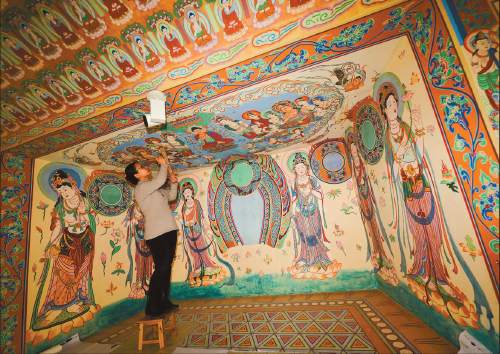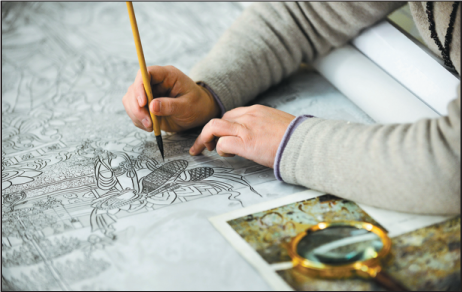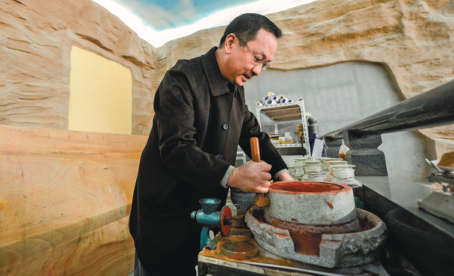
LIU XIAO/XINHUA
Yang Dongmiao reproduces the murals of the No 45 and No 220 grottoes of the Mogao Grottoes in Xi'an, Shaanxi province.

LIU XIAO/XINHUA
Yang sketches a mural before painting it on the wall.

LIU XIAO/XINHUA
Jin Weidong prepares pigments for the murals.
Two artists have dedicated their lives to reproducing the Dunhuang murals, capturing some of the glory of the Tang Dynasty. Ma Lie and Lu Hongyan report from Xi'an, Shaanxi province.
Yang Dongmiao and her husband Jin Weidong are happy and excited-their dream of reproducing full-sized Dunhuang murals is going to come true. "We plan to open our caves to the public on Feb 25, after we finish the murals of the No 45 and No 220 grottoes of the Mogao Grottoes," Jin says. The couple is busy putting the final touches on the murals in their two "grottoes" located on a street that celebrates the heritage of the Silk Road in Xi'an, capital of Shaanxi province.
Some 320 square meters of murals, similar in size to those in the Mogao Grottoes, a UNESCO world heritage in Dunhuang, Northwest China's Gansu province, are almost complete.
The Mogao Grottoes, that date as far back as AD 366, contain more than 45,000 square meters of murals in 735 caves. The grottoes are among the best-preserved Buddhist art treasures in the world.
Yang and Jin started their reproduction of the ancient murals in the two grottoes in 2011, as part of a tourism project to recreate some of the glory of the Tang Dynasty (AD 618-907), China's most prosperous dynasty which chose Xi'an (known as Chang'an in ancient times) as its capital.
"We got the opportunity and financial support from the project developer to realize our long-held dream of completely reproducing the full-size murals in the No 45 and No 220 caves," Yang says.
They selected the murals in the two caves because they are among the best representatives of the Tang Dynasty grotto murals. "The murals in the two caves well reflected the characteristics of that era and visitors to the replica murals can learn something about the history and enjoy the art. We duplicated the murals because the two grottoes were not open to the public," Yang says.
Yang developed an interest in murals when she was a young child. Her father, Yang Tongle, was an artist who worked in heritage management and research at the Mogao Grottoes for 20 years from 1951.
"My father brought back a large amount of research materials and sketch drawings of the murals in the Mogao Grottoes when he returned to Xi'an," Yang says. "I very much liked to read my father's mural manuscripts. It was like reading picture books when I was only 4 years old."
When she was 6, Yang's father started to teach her how to draw in the style of the murals.
In 1989, Yang entered the Xi'an Academy of Fine Arts to study murals and after her graduation in 1993, she was given a job in a government department in Xi'an. She soon left that job to join her father's painting studio as an assistant.
From her first day working in the studio, Yang was determined to learn the line drawing techniques and calligraphy style of the Dunhuang murals.
"I like mural art very much and I want to reproduce the murals because many of the pictures were damaged by natural and anthropogenic factors. I hope my reproduction of the Dunhuang murals can let people see the former glory of the ancient art," Yang says.
It was during that time that Yang met her future husband Jin, a part-time student at Xi'an Academy of Fine Arts where Yang's father worked as a visiting professor of murals. In 1994, Jin visited Yang's father's art studio. He was taken by Yang's concentration and devotion to her mural painting in a quiet corner of the studio.
In the fall of 1994, Jin accompanied Yang on her annual Dunhuang mural study trip, which she had always taken alone.
The two fell in love and Jin joined Yang in studying the Dunhuang murals.
In 1995, just one month after Yang and Jin were married, Yang went to Beijing to study for a masters degree in mural painting at the Art Academy of the People's Liberation Army.
In the summer of 1997, Yang's family was given five residential apartments as compensation after their old house was demolished for urban construction. Yang Dongmiao was given two of the five apartments.
Then Yang made two surprising decisions. One was abandoning her study in Beijing to return to Xi'an, another was to sell her two apartments for 450,000 yuan ($74,484) to invest in the reproduction of the Dunhuang frescoes.
Yang and Jin rented an abandoned factory with an area of 200 square meters in a southwest suburb of Xi'an for 1,000 yuan a month, and started their project.
Working in the shop was tough. One day, Jin broke a leg falling from a 4-meter-high shelf. However, the couple overcame the difficulties and relished the hard work.
"Every time I stood in front of the canvas and drew, I felt like I was communicating with the ancient people and living with them. I feel so proud that we have such beautiful and brilliant art in our history," Yang says.
The couple attempt to draw each line of their mural exactly as it appears on the original, using quality paint and canvas.
By the end of 2000, they had successfully reproduced 256 Dunhuang murals, at a cost of over 1 million yuan.
In 2001, part of their work was displayed in Foshan Library in Guangdong province, and received high praise.
The successful exhibition encouraged the couple to further develop their work and they received support from Duan Wenjie, the former director of Dunhuang Academy, who provided study materials and photos of the ancient murals for the couple's work.
"Some of the grottoes are not open to the public but we received photos of all the murals in the grottoes thanks to Duan's help," Jin says.
In 2011, the couple got the chance to reproduce Dunhuang murals in two caves on the Silk Road-themed street, a major challenge.
"Previously we painted the Dunhuang murals on canvas and paper, but this time we reproduced the entire mural on the wall. It would cost us a lot to fix if we made mistakes while painting on the wall," Yang says.
It also took a long time for the couple to prepare various kinds of pigments.
"The pigments used by ancient people were made from various ores and we had to also make pigments from these ores to make our paintings as close to the original colors of Dunhuang murals," Yang says.
Some people said the colors of murals by Yang and Jin were too bright, and lack a sense of history. But Jin explained that the colors of the original murals had faded with time.
The couple's hard work over two and a half years was rewarded with a payment of 1.5 million yuan from the project developer.
"We will continue our mural reproduction work with the money. Painting murals is the focus of our lives," Yang says.
We recommend
